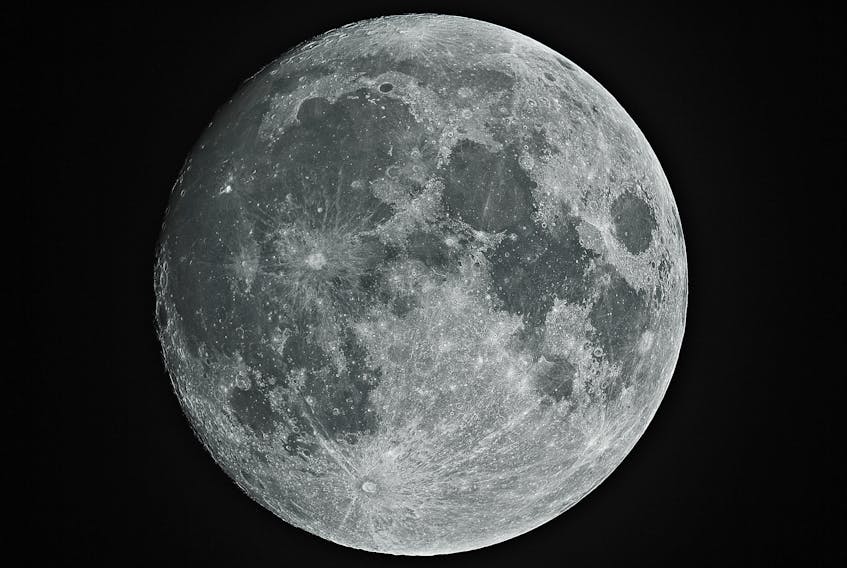Although I was wishing the night sky was devoid of the interfering light of the moon on the nights and mornings preceding and following the Perseid meteor shower's peak dates last week, it did afford me the opportunity to pay closer attention to the slowly-changing phases of the moon.
Most people only notice the full moon, giving little, if any, attention to the other lunar phases. The changing phases of the moon follow a precise timetable, which, once you understand it, might help with your plans, and bolster your interest, to observe the moon.
It is always best to observe the moon, whether with a telescope or binoculars, in its quarter, crescent or gibbous phases. During these phases, the sun's light strikes the moon at a shallower angle (as opposed to directly, at the full moon phase), highlighting the moon's terminator (the line between the illuminated and non-illuminated sides), and markedly defining the moon's mountains, ridges, and impact crater walls.
A lunar phase is defined as the shape of the sunlit portion of the moon's surface as seen from Earth. The moon completely orbits the Earth in an average time of 29.5 days (referred to as a "synodic month" or a "lunation"), marking, essentially, the period between consecutive new moon phases.
Due to variations in the angular rate at which the Earth orbits the sun (based on the fact that the Earth's orbital path around the sun is elliptical, rather than circular, in shape), the actual time between lunations varies between 29.18 days and 29.93 days (the average being 29.530588 days, or 29 days, 12 hours, 44 minutes, and 2.8 seconds).
As the moon orbits the Earth, and as the Earth orbits the sun (also an elliptical path), the area of the sunlit portion of the moon changes. As discussed in one of my earlier columns, gravity tidally locks one side (or face) of the moon towards Earth. Each moon phase depends on the position of the moon relative to the sun as seen from Earth, and the portion of the Earth-facing side that is illuminated by the sun.
There are four distinct lunar phases, with an average of 7.38 days between each of these phases. The first phase, the new moon, is when the sun and the moon are aligned on the same side (called a "conjunction") of Earth. During this time, the moon is too close to the sun to be seen, and the side of the moon facing Earth is not illuminated by the sun (though, in fact, it is faintly lit by "earthshine", which is washed out by the sun's light). In the northern hemisphere, the new moon rises around 6 a.m., and sets around 6 p.m.
The next distinct lunar phase is the first-quarter moon, where the moon's right side is 50 per cent lit by the sun. In the northern hemisphere, first-quarter moons are visible in the afternoon and early evening skies, rising around noon and setting around midnight.
Next is the full moon, with 100 per cent of its Earth-facing side illuminated. Full moons rise at sunset and set at sunrise.
The fourth lunar phase is the last-quarter moon, with 50 per cent of its left side illuminated. A last-quarter moon, visible from late night through the following morning, rises around midnight and sets around noon. It should be noted that the actual timing of the phases in the sky, and their location along the horizon, will vary with the latitude of the observer.
Between the four major phases, there are a number of intermediate phases: between the new moon and the first-quarter moon is the waxing (thickening), crescent moon (right side one to 49.9 per cent lit); between the first-quarter moon and the full moon is the waxing, gibbous moon (right side 50.1-99.9 per cent lit); between the full moon and the last-quarter moon is the waning (thinning), gibbous moon (left side 99.9- 50.1 per cent lit); and between the last-quarter moon and the new moon is the waning, crescent moon (left side 49.9 - 0.1 per cent lit).
If you've ever heard the phrase, "the old moon in the new moon's arms," this refers to when the waning, crescent moon has shrunk to just a thin sliver. Also, the crescent moon (either waxing or waning) is sometimes referred to as the "Cheshire Cat Moon", as it resembles, at some point, the glowing smile that the Cheshire Cat left hanging in the air when it disappeared whilst talking with Alice (in 'Alice in Wonderland').
On a clear night, look for "earthshine" on the unlit, back portion of the crescent moon - a faint illumination caused by indirect sunlight reflecting off Earth's lit half striking that dark side.
This week's sky
Mercury achieves superior solar conjunction (passes behind the sun as seen from Earth) on Aug. 17, and is not observable. Mars (magnitude -1.47) rises in the east around 11:30 p.m., reaching its highest point (49 degrees) in the southern sky shortly after 5 a.m., before being lost in the dawn twilight 47 degrees above the southern horizon by about 6 a.m.
Mighty Jupiter (magnitude -2.65) is visible in the southeast sky around 8:30 p.m., reaching 21 degrees above the southern horizon by 10:45 p.m., before sinking below eight degrees above the southwest horizon shortly after 2 a.m.
Saturn (magnitude +0.23) trails Jupiter across the evening sky, becoming visible to the left of the larger and brighter planet around 8:45 p.m., remaining visible until it, too, disappears from view as it sinks below 10 degrees above the southwest horizon around 2:30 a.m.
Until next week, clear skies.
Events
Aug. 17 - Mercury reaches superior solar conjunction
Aug. 18 - New moon
Aug. 20 - Moon at perihelion (closest approach to the sun)
Aug. 21 - Moon at perigee (closest approach to Earth)
Glenn K. Roberts lives in Stratford, P.E.I., and has been an avid amateur astronomer since he was a small child. He welcomes comments from readers at [email protected].









